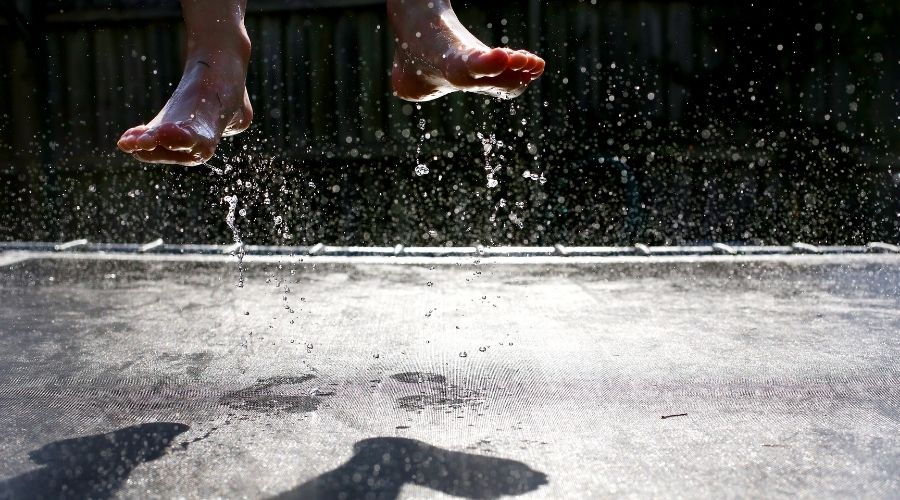Outdoor trampolines take a while to set up, and you can’t be expected to pack them in for every spring shower. Some companies include rain covers to help keep water off these large toys, and you can buy them separately for most models as well.
Moreover, they are built to last in outside conditions. Can trampolines get wet?
Trampolines can get wet as long as they are made for outdoor use. An outdoor trampoline has weatherproof coatings on the frame and springs to prevent rust, and the mat itself is made from polyethylene or nylon fibers that can handle rain and other weather conditions.
Table of Contents
Can You Leave A Trampoline Out In The Rain
So long as you have purchased an outdoor trampoline, you can leave it out in the rain with no worries.
If you prefer to keep it dry, you can buy a cover for when you expect wet weather. However, there’s no concern about damage since these outside toys are durable.
Can Trampolines Get Ruined In The Rain
Outdoor trampolines cannot get ruined in the rain. The springs and legs are coated with waterproofing to help prevent rust and corrosion, and the padding and covers are meant to take on water and dry quickly.
Meanwhile, the mat itself can hold some water without any problems. However, it’s not a good idea to try and move a wet trampoline because the water on and within the mat will add a surprising amount of weight.
Manufacturer errors are rare, but they can happen. If you got an uncoated trampoline, the company would most likely replace it.
That said, you need to make an effort to avoid unnecessary scratches and damage to the metal parts, so the protective coating stays in place.
Is A Trampoline Waterproof
A trampoline is waterproof. Outdoor trampolines are built to withstand the weather in most climates. Usually, that includes rain.
A company making huge, somewhat expensive toys for people’s yards that turn moldy or fall apart in the first good storm would not last very long before it was out of business.
More importantly, it would be dangerous.
Unfortunately, even the best-built outdoor toys won’t last forever.
It’s good to use a cover and look into additional weatherproofing after the first year or two of use, but most outdoor trampolines last for 5-8 years or longer.
Depending on how you use and maintain your trampoline mat, it can last between 3 to 8 years.
If your trampoline is used often, the pad will wear down faster. Luckily, you can replace the pad on a worn-out trampoline.
Can You Jump On A Wet Trampoline
You can jump on a wet trampoline. In fact, it’s a lot of fun, though there’s notably less traction.
Be aware that water will also ‘jump’ as you bounce, so you’ll probably get very wet as you have fun.
Wet trampolines are ideal for summertime when it’s hot as long as the water is cool, but remember to put on your sunscreen because water will help focus the sun’s rays, and you may burn faster than usual.
Do You Jump Higher On A Wet Trampoline
There are no studies I could find on the science of jumping higher on a wet trampoline.
However, there are a lot of reports from children and adults claiming that you do jump higher on a wet trampoline.
While I cannot confirm this, I can offer a reasonable theory for why this would be the case.
A dry trampoline is plenty springy. When you add moisture, it lubricates the rubber making it more pliable, and as a result, it stretches further.
A deeper stretch should make you bounce higher. However, this is only a theory, and until someone does a very entertaining, peer-reviewed study on the subject, no one will know for sure if it’s really a higher bounce or if you’re just having more fun, so it feels like a bigger jump.
Is It Safe To Jump On A Wet Trampoline
It isn’t necessarily safe to jump on a wet trampoline. For one thing, the chances of you slipping when you land are much higher. However, this can be handled easily with a high-quality safety net.
A decent net should keep you and your children from sliding off the trampoline, though it will not keep your feet under you, so there’s still a chance of landing wrong.
Luckily the trampoline surface is typically enough to prevent any injuries. There’s always a small risk when jumping, and it’s not much more significant on a damp trampoline mat.
With decreased traction from the wet surface comes a higher chance of collision. Take turns and jump one at a time when using a wet trampoline.
Otherwise, you may find you can’t get out of the way fast enough to avoid getting landed on.
There is one time when a wet trampoline is never safe to use. If there is a thunderstorm within 25 miles of where you are jumping, please get off the trampoline.
According to Weather.gov, “…many people are unaware that lightning can strike as far as 25 miles away from its parent thunderstorm, much farther out from the area of rainfall within the storm! Therefore, if you can hear thunder, you are within striking distance. Seek safe shelter immediately.”
Helpful Tips To Know About If Trampolines Can Get Wet
Water is not a problem for a properly built outdoor trampoline. Some trampoline styles come with misters around the top of the net for more fun in hot weather.
Here are more helpful tips to know about if trampolines can get wet.
- Indoor trampolines are not the same as their outdoor cousins. For one thing, they may not have UV protection. However, they also tend to be less resistant to moisture-related issues like rust and mildew. Please use an outdoor trampoline if you plan to get it wet.
- Please do not use water on small personal trampolines. These mini-trampolines don’t offer the same surface area or safety nets as some larger models, so it’s unsafe to use them wet. Even if it’s an outdoor model, a small trampoline doesn’t leave you any room to fall safely. You could end up on the ground with broken bones if you’re not careful.
- Always follow the manufacturer’s recommendations. If you plan to jump in wet weather, after the rain passes, or you want to use a hose, read the information about your trampoline first. You can also contact the manufacturer or customer service line directly if there’s no safety information about water included.
- You should check your trampoline springs once per month and replace any worn, rusty, or damaged parts before using the trampoline again. Rain and water can contribute to spring corrosion and failure if not adequately sealed.
Final Thoughts
There’s nothing wrong with a wet outdoor trampoline. Always use a safety net if you plan to jump on a wet trampoline, and don’t jump if you can hear thunder, even if you think it’s far enough away.
If you plan to spend a lot of time outdoors jumping in the summer, you can look into trampolines with nets and misters built into them to stay cool and wet as you jump.
Adding some water to the mix while you bounce can be a lot of fun so long as you are safe about it.

